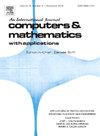通过多边形模板的简单张拉有限元的公式和变换
IF 2.5
2区 数学
Q1 MATHEMATICS, APPLIED
引用次数: 0
摘要
本文介绍了一种统一的方法来构造各种部分连续张量值有限元的基函数。这些有限元素空间对于实现包含张量值函数的偏微分方程混合公式的适定离散是必不可少的,例如线性弹性的Hellinger-Reissner公式。在我们提出的多边形模板方法中,基函数由与参考单纯形的几何多边形(顶点、边、面等)和任何标量值h1 -符合有限元空间相关联的模板张量构造。从这个起点,我们可以构建Regge、Hellan-Herrmann-Johnson、Pechstein-Schöberl、Hu-Zhang、Hu-Ma-Sun和Gopalakrishnan-Lederer-Schöberl元素。由于Hu-Zhang元素和Hu-Ma-Sun元素不能通过标准的双Piola映射从参考单纯形映射到物理单纯形,我们也证明了多边形模板张量可以用来定义物理网格中从参考单纯形到非仿射单纯形的一致映射。最后,我们用两个Reissner-Mindlin板问题的数值例子讨论了单元规则性的含义。本文章由计算机程序翻译,如有差异,请以英文原文为准。
Formulae and transformations for simplicial tensorial finite elements via polytopal templates
We introduce a unified method for constructing the basis functions of a wide variety of partially continuous tensor-valued finite elements on simplices using polytopal templates. These finite element spaces are essential for achieving well-posed discretisations of mixed formulations of partial differential equations that involve tensor-valued functions, such as the Hellinger–Reissner formulation of linear elasticity. In our proposed polytopal template method, the basis functions are constructed from template tensors associated with the geometric polytopes (vertices, edges, faces etc.) of the reference simplex and any scalar-valued -conforming finite element space. From this starting point we can construct the Regge, Hellan–Herrmann–Johnson, Pechstein–Schöberl, Hu–Zhang, Hu–Ma–Sun and Gopalakrishnan–Lederer–Schöberl elements. Because the Hu–Zhang element and the Hu–Ma–Sun element cannot be mapped from the reference simplex to a physical simplex via standard double Piola mappings, we also demonstrate that the polytopal template tensors can be used to define a consistent mapping from a reference simplex even to a non-affine simplex in the physical mesh. Finally, we discuss the implications of element regularity with two numerical examples for the Reissner–Mindlin plate problem.
求助全文
通过发布文献求助,成功后即可免费获取论文全文。
去求助
来源期刊

Computers & Mathematics with Applications
工程技术-计算机:跨学科应用
CiteScore
5.10
自引率
10.30%
发文量
396
审稿时长
9.9 weeks
期刊介绍:
Computers & Mathematics with Applications provides a medium of exchange for those engaged in fields contributing to building successful simulations for science and engineering using Partial Differential Equations (PDEs).
 求助内容:
求助内容: 应助结果提醒方式:
应助结果提醒方式:


